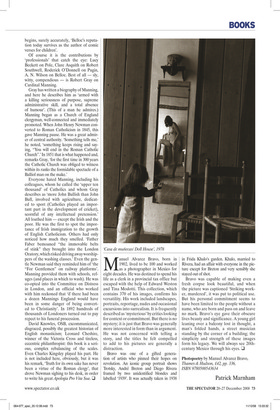M anuel Alvarez Bravo, born in 1902, lived to be 100
and worked as a photographer in Mexico for eight decades. He was destined to spend his life as a clerk in a provincial tax office but escaped with the help of Edward Weston and Tina Modotti. This collection, which contains 370 of his images, confirms his versatility. His work included landscapes, portraits, reportage, nudes and occasional excursions into surrealism. It is frequently described as ‚Äėmysterious‚Äô by critics looking for context or commitment. But there is no mystery; it is just that Bravo was generally more interested in form than in argument. He was not concerned with telling a story, and the titles he felt compelled to add to his pictures are generally a distraction.
Bravo was one of a gifted generation of artists who pinned their hopes on revolution. An iconic group portrait shows Trotsky, Andr√© Breton and Diego Rivera framed by two unidentified blondes and labelled ‚Äė1939‚Äô. It was actually taken in 1938 in Frida Khalo‚Äôs garden. Khalo, married to Rivera, had an affair with everyone in the picture except for Breton and very sensibly she stayed out of shot.
Bravo was capable of making even a fresh corpse look beautiful, and when the picture was captioned ‚ÄėStriking worker, murdered‚Äô, it was put to political use. But his personal commitment seems to have been limited to the people without a name, who are born and pass on and leave no mark. Bravo‚Äôs eye gave their obscure lives beauty and significance. A young girl leaning over a balcony lost in thought, a man‚Äôs folded hands, a street musician standing by the corner of a building; the simplicity and strength of these images form his legacy. We will always see 20thcentury Mexico through his eyes. ‚ĚĎ






















































































































 Previous page
Previous page